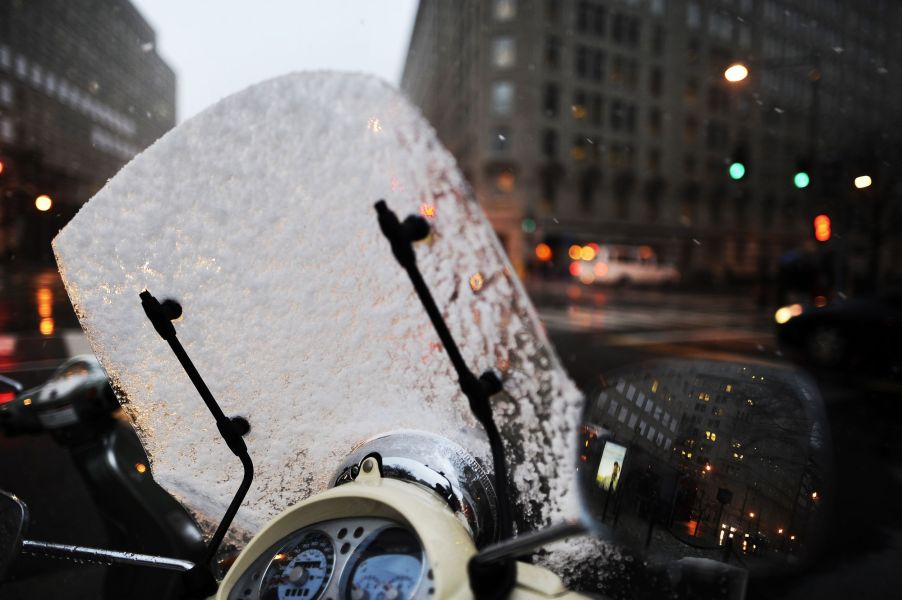
Stop the Wind Blast and Give Your Motorcycle a Windshield
If you fit a quickshifter or slipper clutch to your bike, performance is undoubtedly on your mind. However, some accessories and mods do more than just make your motorcycle faster or sharper. True, tank grips do help you control your motorcycle better, but they also improve your ride by reducing arm strain. And they’re not the only things that can help stay out longer in the saddle. Even if you don’t regularly tour across vast distances, you should strongly consider installing a motorcycle windshield.
A motorcycle windshield can keep you comfortable, protected, and riding longer

While riding a motorcycle involves confronting plenty of potential hazards, the wind isn’t often considered one of them. True, it’s not as dangerous per se as a distracted driver, for example, or a patch of black ice. However, the wind can do more than just blow you off course.
Firstly, riding at high speeds creates enough wind noise to potentially damage your hearing. But the wind doesn’t just carry sound. It also carries things like kicked-up road debris, low-flying birds, and clouds of insects. Even the best motorcycle helmets can only absorb so much force. Ditto your armored gear.
Wind drag is arguably a bigger issue, though. Just like cars, moving motorcycles encounter air resistance. This creates drag, which increases proportional to the cube of velocity, RevZilla explains. However, bikes don’t have fully enclosed metal bodies to absorb the drag force. Instead, your body takes it. And as pro racers like Patricia Fernandez can attest to, this strain adds up quickly. Plus, enough drag can threaten to blow you off your bike—ask me how I know.
Then there’s the heat or rather lack of it. As speed rises, so does the rate of convective heat transfer to the surrounding air. In other words, the faster you go, the worse the wind chill gets. 50° F feels like 38° F at 70 mph, CycleFish notes. Not only is that dangerous, but it’s also tiring.
Fortunately, a motorcycle windshield can help. For one, it puts a physical barrier between you and possible projectiles. Secondly, motorcycle windshields create a bubble around the rider by redirecting oncoming air. Also, because the bubble is relatively calm, there’s less wind noise. The end result is a safer, less-fatigued rider.
Motorcycle windshields don’t need fairings, but they do need to be properly sized
You’ll often see windshields on touring motorcycles, especially ones with fairings like the Harley-Davidson Electra Glide. But just because a bike lacks a fairing doesn’t mean you can’t fit a windshield to it. You can also mount windshields to the bike’s handlebars or its fork tubes, Cruiser reports. And if you only need the windshield sometimes, there are quick-release mount options.
Provided you have the right mounting hardware, you can attach a windshield to your motorcycle with just a few hand tools. Some companies make model-specific windshields, while others are universal-fit. However, some bikes may require special care during installation. For example, I’d have to temporarily remove my 2012 Triumph Street Triple R’s headlights to install the $166 Puig windscreen’s mounting brackets.

Speaking of my Street Triple, it already has a windshield—sort of. My bike has a ‘flyscreen,’ which is basically a very tiny fairing. A ‘windscreen,’ on the other hand, is essentially a shrunken-down windshield. Windscreens and flyscreens are usually seen on naked bikes and café racers because their smaller size fits these motorcycles’ stripped-down aesthetics. They do provide some wind-blocking benefits, but they’re not as effective as a full-size windshield.
Sportbikes like the Suzuki Hayabusa also tend to have smaller windshields than touring bikes. However, that’s because they’re designed with different aerodynamic needs in mind. Also, their fairings usually pick up the remaining air-redirecting slack.
While larger windshields do block more wind, you can’t just install the biggest one available. Although they’re see-through when new, bike windshields get damaged and bug-splattered just as frequently as car ones. That’s a problem if your windshield is so tall that you have to peer through it to scan the road ahead, FortNine explains. Ideally, the windshield should be no taller than the tip of your nose.
Your bike’s windshield needs just as much care as the rest of your gear
As noted earlier, motorcycle windshields get just as abused as car windshields. So, just like the rest of your gear, they have to be cleaned and properly maintained. However, bike windshields require different care than automotive ones, Motorcyclist notes.
While car windshields are made of glass, motorcycle windshields and windscreens are made of acrylic or polycarbonate plastic. You can’t use glass cleaner on them, especially not an ammonia-based solution, because that degrades the plastic. If you can’t get an acrylic- or polycarbonate-safe cleaning solution, stick to mild soap and water. And while most bike windshields have anti-scratch coatings, they’re still easier to scratch than glass ones. So, rather than paper towels, use microfiber or cotton cloths.
Also, like a car’s headlights, motorcycle windshields degrade with repeated UV light exposure. So, after cleaning the windshield, apply an approved plastic protectant. Don’t use regular Rain-X, though, Motorcyclist warns, because its petroleum-based formula also degrades plastic. And if you have a quick-release mount, store your windshield away from bright sunlight when it’s not in use.
There’s a lot that goes into installing a windshield on your motorcycle. But it’s not a particularly difficult process. And your body, from your ears to your muscles, will thank you for taking the time to do it.
Follow more updates from MotorBiscuit on our Facebook page.


